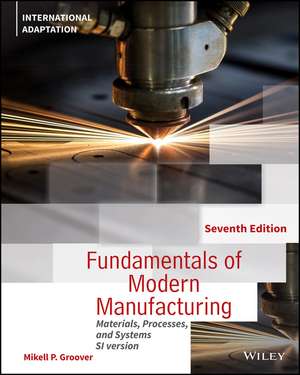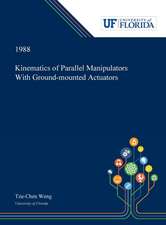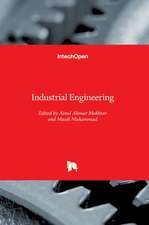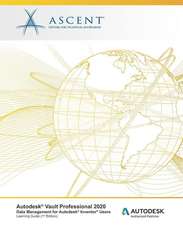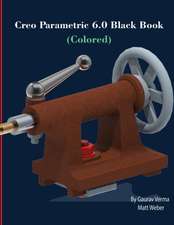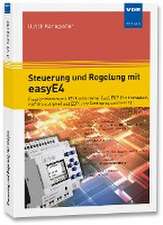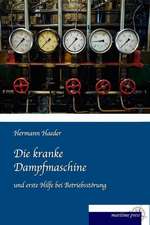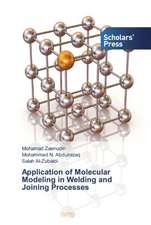Fundamentals of Modern Manufacturing – Materials, Processes and Systems, 7th Edition International Adaptation
Autor MP Grooveren Limba Engleză Paperback – 11 iul 2021
Preț: 423.87 lei
Nou
Puncte Express: 636
Preț estimativ în valută:
81.12€ • 84.17$ • 67.80£
81.12€ • 84.17$ • 67.80£
Carte disponibilă
Livrare economică 25 februarie-11 martie
Livrare express 08-14 februarie pentru 90.98 lei
Preluare comenzi: 021 569.72.76
Specificații
ISBN-13: 9781119706427
ISBN-10: 1119706424
Pagini: 1008
Dimensiuni: 205 x 251 x 32 mm
Greutate: 1.72 kg
Ediția:7th Edition, International Adaptation
Editura: Wiley
Locul publicării:Hoboken, United States
ISBN-10: 1119706424
Pagini: 1008
Dimensiuni: 205 x 251 x 32 mm
Greutate: 1.72 kg
Ediția:7th Edition, International Adaptation
Editura: Wiley
Locul publicării:Hoboken, United States
Cuprins
1 INTRODUCTION AND OVERVIEW OF MANUFACTURING
1.1 What Is Manufacturing?
1.2 Materials in Manufacturing
1.3 Manufacturing Processes
1.4 Production Systems
1.5 Manufacturing Economics
Part I Engineering Materials and Product Attributes
2 THE NATURE OF MATERIALS
2.1 Atomic Structure and the Elements
2.2 Bonding between Atoms and Molecules
2.3 Crystalline Structures
2.4 Noncrystalline (Amorphous) Structures
2.5 Engineering Materials
3 MECHANICAL PROPERTIES OF MATERIALS
3.1 Stress-Strain Relationships
3.2 Hardness
3.3 Effect of Temperature on Properties
3.4 Fluid Properties
3.5 Viscoelastic Behavior of Polymers
4 PHYSICAL PROPERTIES OF MATERIALS
4.1 Volumetric and Melting Properties
4.2 Thermal Properties
4.3 Mass Diffusion
4.4 Electrical Properties
4.5 Electrochemical Processes
5 ENGINEERING MATERIALS
5. 1 Metals and Their Alloys
5.2 Ceramics
5.3 Polymers
5.4 Composite Materials
6 DIMENSIONS, SURFACES, AND THEIR MEASUREMENT
6.1 Dimensions, Tolerances, and Related Attributes
6.2 Conventional Measuring Instruments and Gages
6.3 Surfaces
6.4 Measurement of Surfaces
6.5 Effect of Manufacturing Processes
Part II Solidification Processes
7 FUNDAMENTALS OF METAL CASTING
7.1 Overview of Casting Technology
7.2 Heating and Pouring
7.3 Solidification and Cooling
8 METAL CASTING PROCESSES
8.1 Sand Casting
8.2 Other Expendable-Mold Casting Processes
8.3 Permanent-Mold Casting Processes
8.4 Foundry Practice
8.5 Casting Quality
8.6 Castability and Casting Economics
8.7 Product Design Considerations
9 GLASSWORKING
9.1 Raw Materials Preparation and Melting
9.2 Shaping Processes in Glassworking
9.3 Heat Treatment and Finishing
9.4 Product Design Considerations
10 SHAPING PROCESSES FOR PLASTICS
10.1 Properties of Polymer Melts
10.2 Extrusion
10.3 Production of Sheet and Film
10.4 Fiber and Filament Production (Spinning)
10.5 Coating Processes
10.6 Injection Molding
10.7 Compression and Transfer Molding
10.8 Blow Molding and Rotational Molding
10.9 Thermoforming
10.10 Casting
10.11 Polymer Foam Processing and Forming
10.12 Product Design Considerations
11 PROCESSING OF POLYMER MATRIX COMPOSITES AND RUBBER
11.1 Overview of PMC Processing
11.2 Open-Mold Processes
11.3 Closed-Mold Processes
11.4 Other PMC Shaping Processes
11.5 Rubber Processing and Shaping
11.6 Manufacture of Tires and Other Rubber Products
Part III Particulate Processing of Metals and Ceramics
12 POWDER METALLURGY
12.1 Characterization of Engineering Powders
12.2 Production of Metallic Powders
12.3 Conventional Pressing and Sintering
12.4 Alternative Pressing and Sintering Techniques
12.5 Powder Metallurgy Materials and Economics
12.6 Product Design Considerations in Powder Metallurgy
13 PROCESSING OF CERAMICS AND CERMETS
13.1 Processing of Traditional Ceramics
13.2 Processing of New Ceramics
13.3 Processing of Cermets
13.4 Product Design Considerations
Part IV Metal Forming and Sheet Metalworking
14 FUNDAMENTALS OF METAL FORMING
14.1 Overview of Metal Forming
14.2 Material Behavior in Metal Forming
14.3 Temperature in Metal Forming
14.4 Strain Rate Sensitivity
14.5 Friction and Lubrication in Metal Forming
14.6 Forming Limit Diagram
15 BULK DEFORMATION PROCESSES IN METAL WORKING
15.1 Rolling
15.2 Forging
15.3 Extrusion
15.4 Wire and Bar Drawing
16 SHEET METALWORKING
16.1 Cutting Operations
16.2 Bending Operations
16.3 Drawing
16.4 Equipment and Economics for Sheet-Metal Pressworking
16.5 Other Sheet-Metal-Forming Operations
16.6 Sheet-Metal Operations Not Performed on Presses
16.7 Bending of Tube Stock
Part V Material Removal Processes
17 THEORY OF METAL MACHINING
17.1 Overview of Machining Technology
17.2 Theory of Chip Formation in Metal Machining
17.3 Force Relationships and the Merchant Equation
17.4 Power and Energy Relationships in Machining
17.5 Cutting Temperature
18 MACHINING OPERATIONS AND MACHINE TOOLS
18.1 Machining and Part Geometry
18.2 Turning and Related Operations
18.3 Drilling and Related Operations
18.4 Milling
18.5 Machining Centers and Turning Centers
18.6 Other Machining Operations
18.7 Machining Operations for Special Geometries
18.8 High-Speed Machining
19 CUTTING-TOOL TECHNOLOGY
19.1 Tool Life
19.2 Tool Materials
19.3 Tool Geometry
19.4 Cutting Fluids
20 ECONOMIC AND PRODUCT DESIGN CONSIDERATIONS IN MACHINING
20.1 Machinability
20.2 Tolerances and Surface Finish
20.3 Machining Economics
20.4 Product Design Considerations in Machining
21 GRINDING AND OTHER ABRASIVE PROCESSES
21.1 Grinding
21.2 Related Abrasive Processes
22 NONTRADITIONAL MACHINING AND THERMAL CUTTING PROCESSES
22.1 Mechanical Energy Processes
22.2 Electrochemical Machining Processes
22.3 Thermal Energy Processes
22.4 Chemical Machining
22. 5 Hybrid Machining Systems
22.6 Application Considerations
Part VI Property Enhancing and Surface Processing Operations
23 HEAT TREATMENT OF METALS
23.1 Annealing
23.2 Martensite Formation in Steel
23.3 Precipitation Hardening
23.4 Surface Hardening
23.5 Heat Treatment Methods and Facilities
24 SURFACE PROCESSING OPERATIONS
24.1 Industrial Cleaning Processes
24.2 Diffusion and Ion Implantation
24.3 Plating and Related Processes
24.4 Conversion Coating
24.5 Vapor Deposition Processes
24.6 Organic Coatings
24.7 Porcelain Enameling and Other Ceramic Coatings
24.8 Thermal and Mechanical Coating Processes
Part VII Joining and Assembly Processes
25 FUNDAMENTALS OF WELDING AND WELDING PROCESSES
25.1 Overview of Welding Technology
25.2 The Weld Joint
25.3 Physics of Welding
25.4 Features of a Fusion-Welded Joint
25.5 Arc Welding
25.6 Resistance Welding
25.7 Oxyfuel Gas Welding
25.8 Other Fusion-Welding Processes
25.9 Solid-State Welding
25.10 Weld Quality
25.11 Weldability and Welding Economics
25.12 Design Considerations in Welding
26 BRAZING, SOLDERING, AND ADHESIVE BONDING
26.1 Brazing
26.2 Soldering
26.3 Adhesive Bonding
27 MECHANICAL ASSEMBLY
27.1 Threaded Fasteners
27.2 Rivets and Eyelets
27.3 Assembly Methods Based on Interference Fits
27.4 Other Mechanical Fastening Methods
27.5 Molding Inserts and Integral Fasteners
27.6 Design for Assembly
27.7 DFMA Guidelines
Part VIII Special Processing and Assembly Technologies (Available in e-text for students)
28 ADDITIVE MANUFACTURING
28.1 Fundamentals of Additive Manufacturing
28.2 Additive Manufacturing Technologies
28.3 Cycle Time and Cost Analysis
28.4 Additive Manufacturing Applications
28.5 File formats of Additive Manufacturing
29 PROCESSING OF INTEGRATED CIRCUITS
29.1 Overview of IC Processing
29.2 Silicon Processing
29.3 Lithography
29.4 Layer Processes Used in IC Fabrication
29.5 Integrating the Fabrication Steps
29.6 IC Packaging
29.7 Yields in IC Processing
30 ELECTRONICS ASSEMBLY AND PACKAGING
30.1 Electronics Packaging
30.2 Printed Circuit Boards
30.3 Printed Circuit Board Assembly
30.4 Electrical Connector Technology
31 MICROFABRICATION TECHNOLOGIES
31.1 Microsystem Products
31.2 Microfabrication Processes
REFERENCES
REVIEW QUESTIONS
32 NANOFABRICATION TECHNOLOGIES
32.1 Nanotechnology Products and Applications
32.2 Introduction to Nanoscience
32.3 Nanofabrication Processes
Part IX Manufacturing Systems
33 AUTOMATION TECHNOLOGIES FOR MANUFACTURING SYSTEMS
33.1 Automation Fundamentals
33.2 Hardware for Automation
33.3 Computer Numerical Control
33.4 Industrial Robotics
34 INTEGRATED MANUFACTURING SYSTEMS
34.1 Material Handling
34.2 Fundamentals of Production Lines
34.3 Manual Assembly Lines
34.4 Automated Production Lines
34.5 Cellular Manufacturing
34.6 Flexible Manufacturing Systems
34.7 Computer-Integrated Manufacturing
34.7.1 Protocols used in Integrated Manufacturing
Part X Manufacturing Support Systems
35 PROCESS PLANNING AND PRODUCTION CONTROL
35.1 Process Planning
35.2 Other Manufacturing Engineering Functions
35.3 Production Planning and Control
35.4 Just-in-Time Delivery Systems
35.5 Lean Production
35.6 Agile Production
REFERENCES
REVIEW QUESTIONS
PROBLEMS
36 QUALITY CONTROL AND INSPECTION
36.1 Product Quality
36.2 Process Capability and Tolerances
36.3 Statistical Process Control
36.4 Quality Programs in Manufacturing
36.5 Inspection Principles
36.6 Modern Inspection Technologies
REFERENCES
STANDARD UNITS USED IN THIS BOOK
ABBREVIATIONS USED IN THIS BOOK
INDEX
